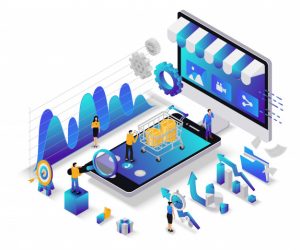Mobile applications have become integral to modern life, serving various purposes from communication and entertainment to business and finance. Expert development of mobile applications ensures that these apps are not only functional but also user-friendly, secure, and scalable. This article explores the key aspects of professional mobile app development, highlighting best practices and essential considerations for creating successful applications.
Understanding the Mobile App Development Process
The mobile app development process consists of several crucial stages, each playing a key role in an app’s success. From concept development and design to testing and deployment, every phase requires careful planning to meet user expectations. In industries like finance, mobile apps provide seamless access to platforms where users can trade forex Thailand efficiently and securely. Proper execution of each development stage ensures a smooth user experience and long-term app performance.
Concept Development
The initial phase involves brainstorming ideas, identifying target audiences, and defining the app’s core functionalities. Clear objectives and a well-defined purpose lay the foundation for a successful application. Market research and competitive analysis are crucial at this stage to ensure the app meets real user needs and stands out in a crowded marketplace.

Design and User Experience
Design plays a pivotal role in the app’s success. A user-centric design ensures that the app is intuitive and easy to navigate. Investing in high-quality user interface (UI) and user experience (UX) design can significantly enhance user satisfaction and engagement. Tools like Sketch and Adobe XD are commonly used to create interactive prototypes and design layouts that resonate with users.
Planning and Strategy
Effective planning and strategy are essential for the smooth execution of mobile app projects. This involves setting clear goals, defining project scope, and establishing timelines. A comprehensive project plan helps in allocating resources efficiently and ensures that the development process stays on track.
Market Research
Conducting thorough market research helps in understanding user needs, preferences, and behaviors. Insights gathered from market research inform design decisions and feature prioritization, ensuring that the app aligns with user expectations. Additionally, analyzing competitors helps identify gaps and opportunities in the market.
Defining Goals and Objectives
Setting specific, measurable, achievable, relevant, and time-bound (SMART) goals provides a clear direction for the development team. These goals guide the development process, helping to prioritize features and make informed decisions. Clear objectives also facilitate effective communication among team members and stakeholders.
Design and User Experience
A well-designed app is crucial for attracting and retaining users. Focus on creating an intuitive interface that offers seamless navigation and an enjoyable user experience. Prioritize simplicity and functionality to enhance usability and reduce the learning curve for new users.
User Interface (UI) Design
UI design focuses on the app’s visual elements, such as colors, typography, and layout. A visually appealing design enhances user engagement and reinforces the app’s brand identity. Consistency in UI elements across different screens ensures a cohesive look and feel, making the app more user-friendly.
User Experience (UX) Design
UX design emphasizes the overall experience of the user when interacting with the app. It involves designing user flows, interactions, and feedback mechanisms that make the app easy to use and navigate. Conducting usability testing during the design phase helps identify and address potential issues, ensuring a smooth user experience.
Development Technologies and Tools
Choosing the right development technologies and tools is critical for building a robust and scalable mobile application. The decision between native and cross-platform development depends on the app’s requirements, budget, and target audience.
Native vs. Cross-Platform Development
Native development involves building apps specifically for a single platform, such as iOS or Android, using platform-specific programming languages like Swift or Kotlin. This approach offers superior performance and access to platform-specific features. Cross-platform development, on the other hand, uses frameworks like React Native or Flutter to build apps that work on multiple platforms, reducing development time and costs.
Essential Development Tools
Utilizing the right development tools can streamline the coding process and enhance productivity. Integrated development environments (IDEs) like Android Studio and Xcode provide comprehensive tools for coding, debugging, and testing. Version control systems like Git facilitate collaboration among developers, ensuring that code is efficiently managed and maintained.
Development Best Practices
Adhering to development best practices ensures that the mobile application is reliable, maintainable, and scalable. These practices encompass coding standards, version control, and collaboration methodologies that contribute to the project’s overall quality.
Coding Standards
Maintaining consistent coding standards across the development team enhances code readability and maintainability. Adopting industry-standard practices, such as using meaningful variable names and modular code structures, facilitates easier debugging and future updates. Regular code reviews help identify and rectify potential issues early in the development process.
Version Control and Collaboration
Implementing version control systems like Git allows developers to track changes, manage code versions, and collaborate efficiently. It ensures that multiple developers can work on the same project without conflicts, maintaining the integrity of the codebase. Collaborative platforms like GitHub and GitLab provide tools for managing repositories, conducting code reviews, and automating workflows.
Testing and Quality Assurance
Thorough testing and quality assurance are crucial for delivering a bug-free and high-performing mobile application. A comprehensive testing strategy includes multiple testing types to identify and fix issues before deployment.
Types of Testing
- Functional Testing: Verifies that all app features work as intended.
- Performance Testing: Assesses the app’s responsiveness and stability under various conditions.
- Security Testing: Ensures that the app protects user data and is resilient against cyber threats.
- Usability Testing: Evaluates the app’s ease of use and overall user experience.
Automated and Manual Testing
Combining automated and manual testing approaches ensures comprehensive coverage and efficiency. Automated testing tools like Appium and Selenium can execute repetitive test cases quickly, while manual testing provides nuanced insights into user interactions and experience.
Deployment and Launch
Deploying the mobile application involves preparing for launch, submitting the app to app stores, and implementing effective deployment strategies. A well-planned deployment ensures that the app reaches its target audience without major issues.
App Store Submission
Submitting the app to app stores like Google Play and Apple App Store requires adherence to their specific guidelines and policies. Proper documentation, including app descriptions, screenshots, and privacy policies, is essential for a smooth approval process. Ensuring compliance with platform requirements minimizes the risk of rejection and delays.
Deployment Strategies
Adopting effective deployment strategies, such as phased rollouts and A/B testing, allows developers to manage the app’s release gradually. This approach helps in identifying and addressing potential issues early, ensuring a stable and reliable launch. Utilizing continuous integration and continuous deployment (CI/CD) pipelines streamlines the deployment process, enhancing efficiency and reducing downtime.
Maintenance and Updates
Post-deployment maintenance is vital for sustaining the app’s performance and relevance in the market. Regular updates, bug fixes, and feature enhancements keep the app competitive and aligned with evolving user needs.
Ongoing Support
Providing ongoing support ensures that users receive timely assistance and that any issues are promptly addressed. Establishing a support system, such as in-app help centers or customer service channels, enhances user satisfaction and loyalty.
Feature Enhancements
Continuously enhancing app features based on user feedback and market trends keeps the app relevant and engaging. Implementing new functionalities and improving existing ones based on user demands fosters long-term user retention and app success.
Security Considerations
Ensuring the security of a mobile application is paramount, especially for apps handling sensitive user data. Robust security measures protect against data breaches, unauthorized access, and other cyber threats.
Data Protection
Implementing strong encryption methods safeguards user data both in transit and at rest. Adhering to data protection regulations, such as GDPR and CCPA, ensures compliance and builds user trust. Additionally, minimizing data collection to only what is necessary reduces the risk of data exposure.
Secure Coding Practices
Adopting secure coding practices during development helps in preventing vulnerabilities. Regular security audits and penetration testing identify and address potential security flaws, enhancing the app’s resilience against attacks. Integrating security features, such as multi-factor authentication and secure APIs, further strengthens the app’s security posture.
Leveraging Expertise in Mobile App Development
Engaging expert mobile app developers brings specialized skills and experience to the project, ensuring high-quality outcomes. Experts are adept at navigating the complexities of mobile app development, from selecting the right technologies to implementing best practices.
Hiring Skilled Developers
Hiring skilled developers with a proven track record in mobile app development enhances the project’s success. Experienced developers are proficient in the latest technologies and methodologies, enabling them to deliver robust and scalable applications. Collaborating with experts also facilitates innovative solutions and efficient problem-solving throughout the development process.
Partnering with Development Agencies
Partnering with reputable development agencies provides access to a diverse pool of talent and resources. Agencies often offer a comprehensive range of services, including design, development, testing, and maintenance, ensuring a cohesive and streamlined development process. Additionally, agencies can scale their teams based on project requirements, offering flexibility and efficiency.
In the financial sector, for instance, developing a secure forex trading app like those available through platforms that allow you to trade forex in Thailand requires expertise in both mobile development and financial regulations. Utilizing specialized strategies, such as those found in ICT trading techniques, ensures that the app meets industry standards and user expectations.
Integration with High-Trust Information Resources
Incorporating high-trust information resources enhances an app’s credibility by providing users with reliable data. Linking to authoritative sources such as Google Scholar for academic research or Statista for industry statistics ensures the information remains accurate and up-to-date.
Utilizing Reputable APIs and Services
Integrating APIs from trusted providers guarantees secure and efficient functionalities. For example, using Google Maps API for location services or implementing Stripe for secure payments enhances the app’s features while maintaining high trust standards.
Accessing Industry Standards and Guidelines
Following industry standards from organizations like W3C for web development and IEEE for engineering ensures the app meets quality benchmarks. These frameworks establish best practices for design, development, and testing, fostering consistency and reliability in performance.
Final Thoughts
Expert development of mobile applications requires a comprehensive understanding of the development process, adherence to best practices, and a commitment to quality and security. By leveraging skilled developers, utilizing the right technologies, and maintaining a user-centric approach, businesses can create successful mobile applications that meet user needs and stand out in the competitive market. Integrating high-trust resources and specialized strategies further enhances the app’s credibility and functionality, ensuring long-term success and user satisfaction.





